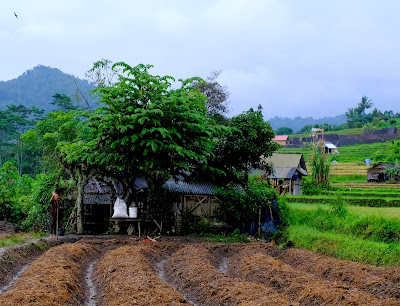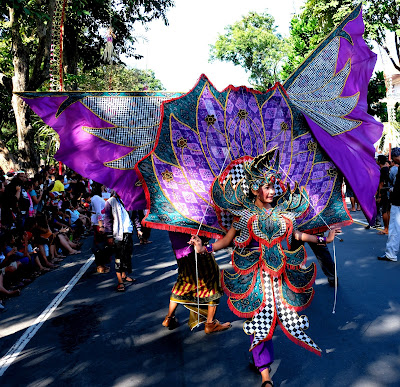We are currently in Sidemen, a heavily agricultural small village in Bali that has seen hotels appear only in the last decade. We went for a ninety minute stroll today (Sarah had found a walking route to the local river) and in that microcosm saw much of what we love in Bali.
First, the amazing scenery - lush fields, tropical trees, with mountain backdrops.
The scene above is the view from our hotel. The picture below is just a few feet down the road.
Buildings are going up everywhere we travel. Typically men are building temporary bamboo structures to support concrete, reinforced by rebar, being poured in place floor by floor. The workers stand on thin beams in high places, appearing fearless and immensely competent.
It's easy to get off-road into the fields, and the ever-present farmers don't object. We stay on the narrow (8") mounded pathways between terraced or flat fields. Farmers often reply politely, or smile or laugh when we greet them with our very few words in Indonesian ("Selemat siang," "Good Mid-day"). If we ask about their crops, they show us what they are growing or harvesting. For most of them, Indonesian is a second language learned in primary school; Balinese is spoken in the home.
Here, Sarah was leading us between a rice field nearing harvest, and a field of chili peppers.
This being a tropical place, we see beautiful flowers and critters.
On our way back from the river, the sky grew dark. Farmers in the fields started carrying their harvest baskets and bags to safety.
As it started to rain, and then pour, we found shelter on a six-foot square platform with a roof above, and a sign in English advertising it as a Pub. The rain sheeting down, we were approached by a farmer wearing the traditional bamboo hat. Like almost everyone we have encountered, she was incredibly tolerant of us as foreigners; she was friendly and inquisitive. We shared with her a snack bar and some bottled water (deploying our few words of Indonesian and some hand-waving), after which she conveyed to us that we should follow her to her house.
At her home, we were greeted by her husband ("Selemat siang!", we said, and "Siang" he said in cheerful reply). The house was a bamboo structure with a corrugated metal roof, about eight feet by twenty, inside which was a cook-fire and pots, a sleeping platform, and chickens. Our hosts made space on the platform for us to sit, moving some of the chickens.
We had what conversation we could given the language barrier. Pointing, we asked about a set of small baskets like those we had seen used for offerings ("banten"). This resulted in the woman giving a demonstration in the deft construction of these little baskets from cut pieces of banana leaf, shaped and stapled with toothpick-like slices of bamboo.
The chickens, in their bamboo baskets, paid occasional attention.
The conversation then moved on to word-sharing, as objects in the room were assigned their Indonesian, Balinese and English names. Coconut is "kelapa" in Indonesian; the Balinese word didn't stick in my head.
Almost everyone we have met in Bali has cheerfully agreed to be photographed. (When posing, many Balinese put on a serious face, which brightens as soon as the picture has been taken. After Amy showed her this picture, the woman laughed about how muddy her feet had gotten walking home in the rain.)
It would only be a short walk back to our hotel. The woman we had met continued to wave as we made our way through her fields, back to the road.

























































